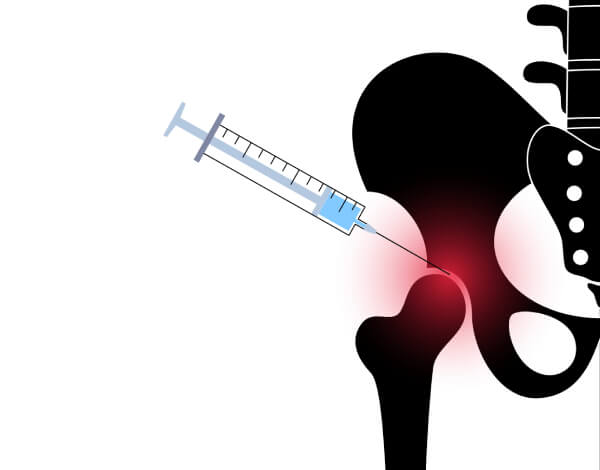Hip Bursitis
What is Hip Bursitis?
Bursae are tiny fluid-filled sacs in various locations within the body, such as the shoulder, hip, knee, elbow, and heel. Bursae act like a cushion for bones, muscles, and tendons and help reduce joint friction. Occasionally, these bursae might get inflamed, which results in a painful condition known as bursitis.
Within the hip, two bursae are prone to getting irritated and inflamed; one is the Trochanteric Bursitis, and the other is the Iliopsoas Bursa. Bursitis can be either acute or chronic.
Treatment usually involves specific exercises and therapies which help reduce the inflammation of the bursa, while surgical treatment is sought only when the former does not achieve the desired outcome.
Let us take a look at the anatomy:
One bursa is located on the bony part of the hip bone called the greater trochanter. Inflammation of this bursa is more common and known as Trochanteric Bursitis.
On the other hand, the Iliopsoas Bursa is found on the inner side of the hip.
What are the causes of Hip Bursitis?
Hip bursitis can affect anyone, but doctors have observed some familiar occurrences.
Roughly 15% of women compared to 8% of men are affected.
The condition is also more prevalent in middle-aged women and older adults.
Specific movements have been known to aggravate the condition, most commonly, continuous repetitive motion that places pressure on the bursae around the hip joint.
Wear and tear of the surrounding hip muscles can also lead to tendinopathy of the gluteus muscles. This is often referred to as Greater Trochanteric Pain syndrome.
In addition, movements that cause hip abduction, such as cycling or climbing the stairs, can result in the inflammation of the bursa.
Other causes of Hip Bursitis:
- Gout: Systemic diseases can trigger hip pain and increase the likelihood of causing hip bursitis.
- Rheumatoid Arthritis/Inflammatory Conditions: This can result in the hip bursa being more prone to inflammation.
- Hip Injury: A hip injury can result when you fall on your hip or bump your hip against a hard surface. Additionally, bed-ridden patients that lie on one side for extended periods can initiate an inflammatory cascade of the bursa.
- Calcium deposits (Bone Spurs): Bony growths or osteophytes occur on top of normal bone, which can harden over time. These bony projections can make it difficult for you to move your hip, thus debilitating your range of motion.
- Previous Surgery: Surgery near the hip or prosthetic implants can irritate the bursa and cause bursitis.
- Jogging: Running especially on a cambered road can cause hip bursitis as one side of the leg lengthens with increased friction on the Hip Bursa.
Symptoms

The most common symptom of hip bursitis is pain and tenderness. You may also notice that the area is swollen and warm to the touch. In acute bursitis, the pain will be sharp within the initial few days, followed by dull, achy pain.
Some specific movements will cause you to notice the aggravating pain, such as getting out of the bed, sitting for too long, and sleeping on the affected side. The pain from acute bursitis will often flare up over days.
However, in chronic bursitis, pain can last a few days, even weeks, if left untreated.
Acute bursitis can also become chronic if any hip injury occurs or the pain gets triggered again.
Occasionally, bursa might thicken with time, which can worsen the swelling. When this happens, you may experience a limitation in movement as the muscles weaken (atrophy) in the affected area.
Investigations
- Your doctor will conduct a thorough physical examination and conduct additional investigations.
- A physical examination is often necessary. Once your doctor has conducted examinations they will move on to recommending specific imaging tests.
- These tests often include an X-rays Ultrasound or MRI.
- Usually, an Xray is sufficient to diagnose the condition, with ultrasounds being the best diagnostic tool as it can help visualize increased fluid within the trochanteric bursa.
Treatment
- Using Non-Steroidal Anti-Inflammatory Drugs (NSAIDs): Medicines like Naproxen, Ibuprofen, Celecoxib, Piroxicam, and more may reduce inflammation and relieve pain.
- Rest: Resting from activity which causes pain or laying on the other side of your body may help greatly.
- ICE: applying an ICE pack in a gentle manner over the affected area may also help.
- Injection: A Steroid Injection into the area if there is fluid can often help the pain settle down.

Exercises: Strengthening the Gluteal muscles often helps the condition long term especially if it is associated with Gluteal muscle tendinopathy
Physical therapy: Your doctor may also recommend exercises to help increase your hip joint strength and flexibility. These exercises can be done on your own, or you can visit a physical therapist who can teach you specific exercises that can stretch your hip muscles.
Prolotherapy: Prolotherapy is a nonsurgical intervention that stimulates the body’s healing response to strengthen the joints that have been exposed to repeated trauma and injury. It involves injecting a small quantity of dextrose solution into the affected area so that the body’s healing response is triggered.
- Exercises: Strengthening the Gluteal muscles often helps the condition long term especially if it is associated with Gluteal muscle tendinopathy
- Physical therapy: Your doctor may also recommend exercises to help increase your hip joint strength and flexibility. These exercises can be done on your own, or you can visit a physical therapist who can teach you specific exercises that can stretch your hip muscles.
- Prolotherapy: Prolotherapy is a nonsurgical intervention that stimulates the body’s healing response to strengthen the joints that have been exposed to repeated trauma and injury. It involves injecting a small quantity of dextrose solution into the affected area so that the body’s healing response is triggered.
Conclusion
Your age, lifestyle, and underlying medical conditions can play a significant role in developing hip bursitis. However, seeking treatment early can prevent the onset and aggravation of the condition.
Physical therapy and activity modifications can help prevent the progression of Hip Bursitis into a long term problem.
Frequently Asked Questions (FAQs)
For an assessment of your Hip Pain
Contact us
We’d love to hear from you!
Just reach out and contact us via any of
these channels:

Call us on

Email us on

Call us on

